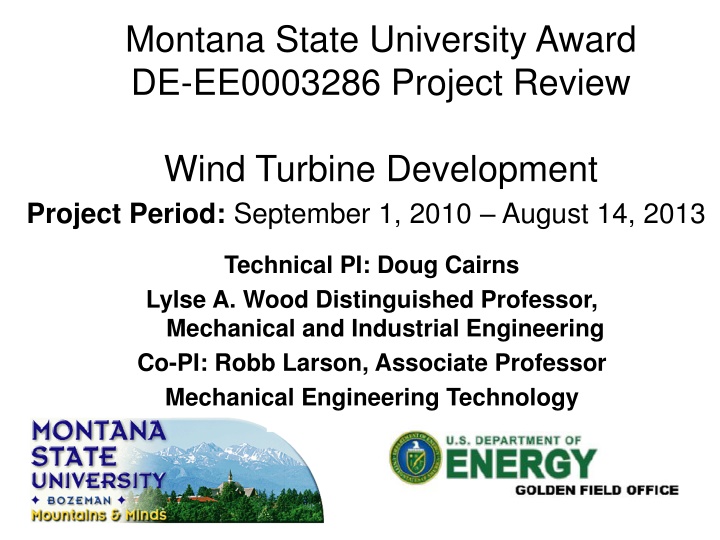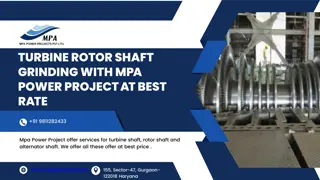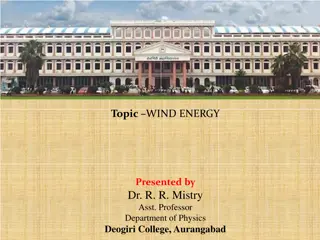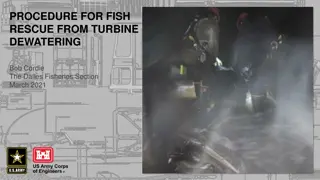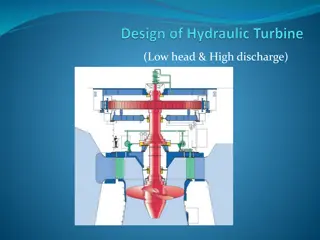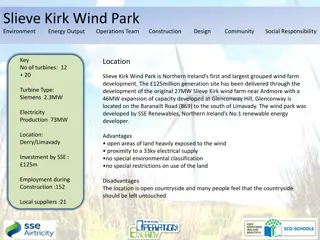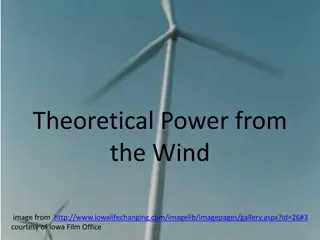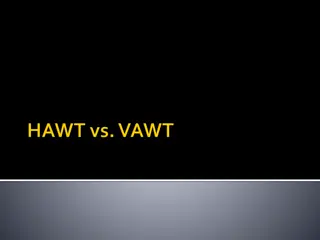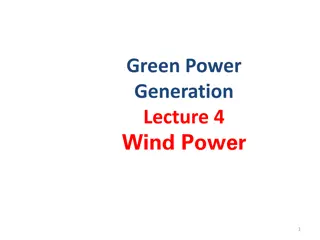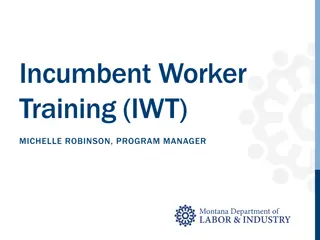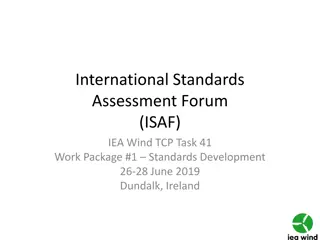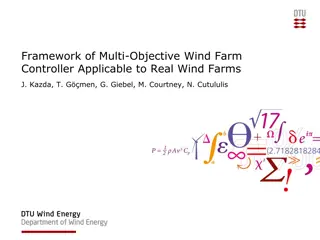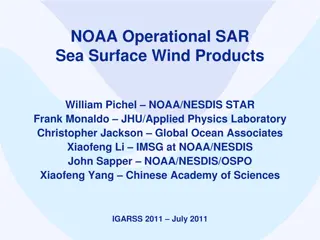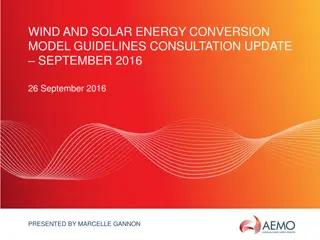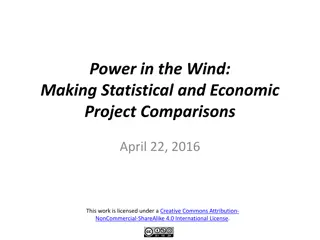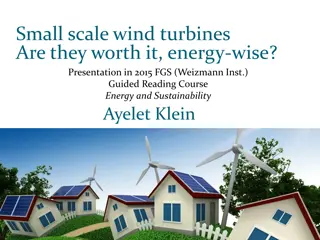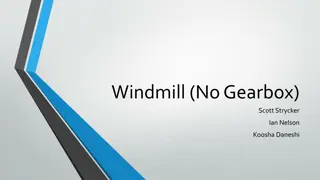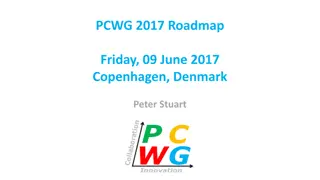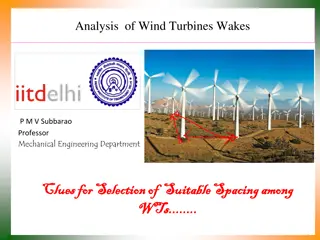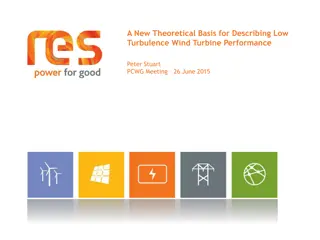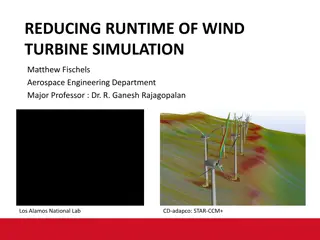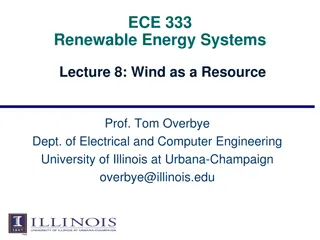Wind Turbine Development Project Review at Montana State University
Montana State University conducted research and development on wind turbine systems to enhance energy independence. The project aimed to improve wind energy resources in Montana, create local jobs, and establish a higher technology economy. Tasks included durability research on turbine blades and manufacturing advancements for components.
Download Presentation

Please find below an Image/Link to download the presentation.
The content on the website is provided AS IS for your information and personal use only. It may not be sold, licensed, or shared on other websites without obtaining consent from the author.If you encounter any issues during the download, it is possible that the publisher has removed the file from their server.
You are allowed to download the files provided on this website for personal or commercial use, subject to the condition that they are used lawfully. All files are the property of their respective owners.
The content on the website is provided AS IS for your information and personal use only. It may not be sold, licensed, or shared on other websites without obtaining consent from the author.
E N D
Presentation Transcript
Montana State University Award DE-EE0003286 Project Review Wind Turbine Development Project Period: September 1, 2010 August 14, 2013 Technical PI: Doug Cairns Lylse A. Wood Distinguished Professor, Mechanical and Industrial Engineering Co-PI: Robb Larson, Associate Professor Mechanical Engineering Technology
The Importance of Wind Energy in Montana Montana has the fifth best wind energy resource of any state, but currently has only about 386 megawatt power generation with wind energy. (Estimated potential of 830,504 megawatt) Benefits of development Short to Medium Term Local power in rural areas A communications infrastructure to stimulate value- added development of its resources (not just wind power extraction) Longer Term Power distribution infrastructure for long term development Establishment of higher technology economy in Montana
Importance of this Award for Montana Value Added for our wind energy resources (estimated from second to fifth in the US) Every MW of installed power creates 2.5 job-years Leverage for higher tech jobs; from windsmith technicians through cutting edge research
Organization of This Review Overview of Statement of Project Objectives (SOPO) Executive Summary of Overall Technical Progress per SOPO Tasks Task Summaries Significant Milestones and Accomplishments Current Status Barriers and Challenges Project Schedule % complete Original completion date Expected completion date Project Financial Metrics (Budget and Status) Government Budget Cost Share Budget Total Budget Period Start Date Cost Share Spent Total Spent Estimated Spend Plan
Project Objectives From the SOPO: Montana State University will perform basic research in wind turbine systems, perform manufacturing research, outreach, and training for manufacturing of wind turbine components. The scope of this project is research and education on wind turbine components, and to apply expertise to help enhance the nation s independence on foreign energy sources.
SOPO Task 1: Research on the durability and damage tolerance of wind turbine blades The fundamental research will be on the design and manufacturing details in wind turbine blades which affect the performance of wind turbine blades. This task will involve testing of design details representative of typical wind turbine blades. Task 1.1 Computer Models MSU will use a finite element analysis package to run simulations. Task 1.2 Analytical Correlations MSU will use numerical analysis to correlate computer models. Task 1.3 Experimental Correlations MSU will do static and dynamic testing on actual blade samples to correlate computer models. Task 1.4 Dissemination The results will be disseminated to wind turbine developers and manufacturers. Dissemination and outreach will be accomplished in several forms: 1) Technical Interchange Meetings with wind turbine developers; 2) Workshops on research and education results; 3) Technical reports available in electronic format. These data will be available for any US development sites.
Task 2.0 Manufacturing studies MSU will initiate manufacturing studies which are not being addressed with other DOE programs. Technology transfer will occur by leveraging this project with needs of US based wind turbine manufacturers. Task 2.1 Local Manufacturing Meetings MSU will organize meetings with local manufacturing companies. The focus of the meetings will be critical manufacturing features/defects with respect to wind turbine blades. This forum will also serve as a outreach activity. Task 2.2 Curriculum Development MSU will use the information gathered in the meetings to augment curriculum development.
Task 3 Technical Interchange Meetings MSU will conduct Technical Interchange meetings with surrounding states on the topic of utility-grade and stand-alone site development Task 3.1 Meetings MSU will organize meetings with surrounding states for the purpose of information sharing. Task 3.2 Curriculum Development MSU will use the information gathered during the meetings to augment curriculum development and research activities.
Task 4. Engage Manufacturers The priority for this outreach will be with companies who show a genuine interest in investing in this research and technology for its sustainability in Montana. Task 4.1 Research Task 4.2 Dissemination MSU will make the findings available to companies who are involved in, or would like to be involved in, manufacturing wind turbine generation controls and hardware.
Significant Achievements, Milestones and Breakthroughs from this Award Extensive table for all reports provided in Milestones and Achievements.pdf Task 1 Research on the durability and damage tolerance of wind turbine blades State of the Art Durability and Damage Tolerance modeling of wind turbine blades (We are not aware of a more comprehensive approach; has implications for all structures made from composite materials) Probabilistic reliability analyses Progressive damage modeling Analytical method development with experimental/analytical correlations
Significant Achievements, Milestones and Breakthroughs from this Award Extensive table for all reports provided in Milestones and Achievements.pdf Task 2 Manufacturing Studies Large scale process modeling Coupled field problem for wind turbine blade manufacturing Flow Heat Transfer Resin Kinetics Experimental/Analytical Correlations Wind turbine blade laminate Joint regions
Significant Achievements, Milestones and Breakthroughs from this Award Extensive table for all reports provided in Milestones and Achievements.pdf Task 3 Technical Interchange Meetings Developed and implemented a range of meetings over a wide stakeholder constituency in wind Research Universities Government Laboratories Manufacturers Policy Makers National Audience International Audience Many stakeholders have engaged this group as a consequence of this award This award has provided support for important organizations ASME Wind Energy Technical Committee North American Wind Energy Academy (NAWEA)
Significant Achievements, Milestones and Breakthroughs from this Award Extensive table for all reports provided in Milestones and Achievements.pdf Task 4 Engage Manufacturers Have continued to be pro-active to bring in manufacturers as collaborators GE Wind Fuhrlander (a company wanting to establish a manufacturing plant in Butte, MT) VESTAS North America TPI (Among the largest wind turbine blade manufacturer in the US) GAMESA (a company very interested in manufacturing defects in wind turbine blades) EDF (the world s largest producer of electricity) EPRI Successful with TPI, GAMESA, EDF, and EPRI Dissemination of results in recognized venues Composite Materials Handbook 17, the US authority on composite materials and structures Local Manufacturers
Other Achievements from This Award Publications 7 peer reviewed 1 invited special issue on reliability of alternative energy systems 15+ presentations and proceedings Technical Audiences Manufacturers Government Leaders and Policy Makers Composite Materials Handbook chapter based on this work Students Post-doctoral researcher (now working on composites, including wind energy in Seattle) 4 PhD Students (one writing dissertation, two successfully passed comprhensive exams, one sucessfully passed PhD. Qualifying Exam Two MS students, approximate way through program 6+ Undergraduate students
Other Achievements from This Award (cont.) Faculty Development PI Chairman, ASME Wind Energy Technical Committee Chairman, North American Wind Energy Academy Charter Committee Co-PI Director, Montana Wind Applications Center Developed Renewable Energy Curricula throughout Montana This award has enabled a Community of Scholars for Wind Energy in Montana from STEM through University Faculty
Significant Events Which Occurred Since the Inception of this Award Economic downturn resulted in significantly less installed wind turbine developments Wind turbine companies have backed away from R&D in some cases (especially international companies who have developed technical presence in US) Production Tax Credits for wind energy have had a significant impact on corporate wind turbine Research and Development However, this award has held the course for the importance of the tasks.
Barriers and Challenges Logistical During initial discussions of this project, the wind energy industry was growing at a rate of around 20%/year, has dropped off sharply from that Project lost momentum between appropriation in Fall 2009 and contract award in August 2010
Barriers and Challenges (cont.) Technical Probabilistic Modeling more difficult than first envisioned Damage Database (from industry) Combination of Distributions Computational intensity Manufacturing Coupled field problem (mass, momentum, heat transfer, chemistry) difficult Integration into commercial computer codes Progressive Damage Modeling more complicated than originally thought Compatibility with commercial computer codes to provide utility for industry Stability of progressive damage growth
Barriers and Challenges (cont.) Other Recognition of importance from industry, but reluctance to collaborate because of Proprietary issues Wind turbine component manufacturers with prior serious interest in locating in Montana are on standby.
